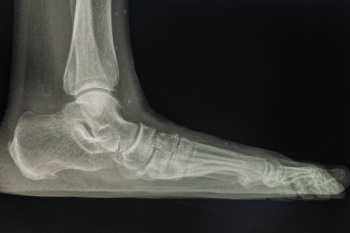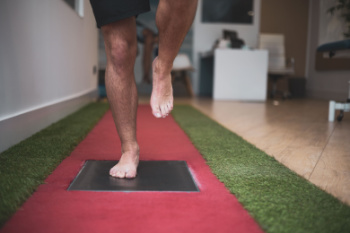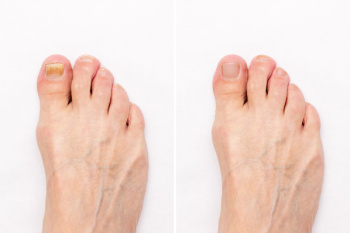Items filtered by date: March 2024
The Necessity and Benefits of Hammertoe Surgery

Hammertoe, a deformity characterized by an abnormal bending of the toe joint, can lead to discomfort, difficulty walking, and even pain during daily activities. While many cases of hammertoe can be managed with conservative measures such as padding, shoe modifications, and orthotic devices, surgery may be necessary in certain instances. Hammertoe surgery becomes essential when the condition progresses to a point where conservative treatments no longer provide relief or when the deformity interferes significantly with mobility and quality of life. During surgery, the surgeon may release tight tendons, reposition bones, or remove damaged tissue to straighten and realign the affected toe. Although surgery involves risks like any medical procedure, it can offer long-term relief and improve functionality for individuals suffering from severe hammertoe deformities. If you are living with hammertoe, it is strongly suggested that you are under the care of a podiatrist who can determine if surgery is the correct choice for you.
Foot surgery is sometimes necessary to treat a foot ailment. To learn more, contact Elliot T. Udell, DPM of New York. Our doctor will assist you with all of your foot and ankle needs.
When Is Surgery Necessary?
Foot and ankle surgery is generally reserved for cases in which less invasive, conservative procedures have failed to alleviate the problem. Some of the cases in which surgery may be necessary include:
- Removing foot deformities like bunions and bone spurs
- Severe arthritis that has caused bone issues
- Cosmetic reconstruction
What Types of Surgery Are There?
The type of surgery you receive will depend on the nature of the problem you have. Some of the possible surgeries include:
- Bunionectomy for painful bunions
- Surgical fusion for realignment of bones
- Neuropathy decompression surgery to treat nerve damage
Benefits of Surgery
Although surgery is usually a last resort, it can provide more complete pain relief compared to non-surgical methods and may allow you to finally resume full activity.
Surgical techniques have also become increasingly sophisticated. Techniques like endoscopic surgery allow for smaller incisions and faster recovery times.
If you have any questions please feel free to contact our office located in Hicksville, NY . We offer the newest diagnostic and treatment technologies for all your foot and ankle needs.
Athletes and Flat Feet

Athletes often face various challenges in their pursuit of excellence, and flat feet can present an additional hurdle to overcome. Flat feet, or fallen arches, occur when the arch of the foot collapses, causing the entire sole to make contact with the ground. This condition can lead to discomfort, instability, and an increased risk of injury during physical activity. However, many athletes with flat feet have found effective ways to cope and excel in their sports. One important strategy involves wearing supportive footwear with proper arch support and cushioning to help distribute weight evenly and reduce strain on the feet. Additionally, incorporating exercises to strengthen the muscles surrounding the feet and ankles can improve stability and alignment, enhancing overall performance and reducing the risk of injury. Seeking guidance from a podiatrist can also provide valuable insights and personalized recommendations for managing flat feet while pursuing athletic goals. If you have flat feet and participate in sporting activities, it is suggested that you consult a podiatrist who can offer you additional relief strategies.
Flatfoot is a condition many people suffer from. If you have flat feet, contact Elliot T. Udell, DPM from New York. Our doctor will treat your foot and ankle needs.
What Are Flat Feet?
Flatfoot is a condition in which the arch of the foot is depressed and the sole of the foot is almost completely in contact with the ground. About 20-30% of the population generally has flat feet because their arches never formed during growth.
Conditions & Problems:
Having flat feet makes it difficult to run or walk because of the stress placed on the ankles.
Alignment – The general alignment of your legs can be disrupted, because the ankles move inward which can cause major discomfort.
Knees – If you have complications with your knees, flat feet can be a contributor to arthritis in that area.
Symptoms
- Pain around the heel or arch area
- Trouble standing on the tip toe
- Swelling around the inside of the ankle
- Flat look to one or both feet
- Having your shoes feel uneven when worn
Treatment
If you are experiencing pain and stress on the foot you may weaken the posterior tibial tendon, which runs around the inside of the ankle.
If you have any questions please feel free to contact our office located in Hicksville, NY . We offer the newest diagnostic and treatment technologies for all your foot and ankle needs.
Understanding Foot Function and Ensuring Proper Care

Our feet, the unsung heroes of our daily activities, are intricate structures that enable mobility and support our entire body weight. Comprising numerous bones, joints, muscles, ligaments, and tendons, the feet work in unison to provide stability, balance, and the ability to walk, run, and stand. Maintaining optimal foot health is essential for overall well-being. To keep our feet in top condition, it is important to choose footwear that provides proper arch support and cushioning, and fits well. Regularly cleaning and inspecting the feet, especially between the toes, can help to prevent infections. Stretching exercises promote flexibility while strengthening exercises help maintain the foot's arch and stability. Alternating shoe choices, wearing moisture-wicking socks, and allowing feet to breathe can prevent issues like fungal infections. Paying attention to any discomfort or pain and seeking timely medical attention ensures prompt intervention. By understanding the marvel of how our feet function and adopting simple yet effective tips, we can prioritize our health and continue to move through life with comfort and ease. If you are seeking additional information about foot function and care, it is suggested that you confer with a podiatrist.
If you have any concerns about your feet, contact Elliot T. Udell, DPM from New York. Our doctor can provide the care you need to keep you pain-free and on your feet.
Biomechanics in Podiatry
Podiatric biomechanics is a particular sector of specialty podiatry with licensed practitioners who are trained to diagnose and treat conditions affecting the foot, ankle and lower leg. Biomechanics deals with the forces that act against the body, causing an interference with the biological structures. It focuses on the movement of the ankle, the foot and the forces that interact with them.
A History of Biomechanics
- Biomechanics dates back to the BC era in Egypt where evidence of professional foot care has been recorded.
- In 1974, biomechanics gained a higher profile from the studies of Merton Root, who claimed that by changing or controlling the forces between the ankle and the foot, corrections or conditions could be implemented to gain strength and coordination in the area.
Modern technological improvements are based on past theories and therapeutic processes that provide a better understanding of podiatric concepts for biomechanics. Computers can provide accurate information about the forces and patterns of the feet and lower legs.
Understanding biomechanics of the feet can help improve and eliminate pain, stopping further stress to the foot.
If you have any questions please feel free to contact our office located in Hicksville, NY . We offer the newest diagnostic and treatment technologies for all your foot and ankle needs.
Understanding Contagion Risks of Toenail Fungus

Toenail fungus, also known as onychomycosis, is a common fungal infection that affects the nails. This condition is typically characterized by discoloration, thickening, and crumbling of the nails. While toenail fungus is not considered extremely contagious, it can spread from person to person under certain circumstances. Direct contact with infected nails or contaminated surfaces such as shower floors, swimming pools, and communal areas can facilitate transmission. Additionally, sharing shoes, socks, or nail clippers with an infected individual increases the risk of contracting the fungus. Individuals with compromised immune systems, diabetes, or poor circulation are more susceptible to toenail fungus and may experience more severe infections. Maintaining good foot hygiene, wearing breathable footwear, avoiding sharing personal items, and keeping nails trimmed and dry can help reduce the risk of toenail fungus transmission. If you have toenail fungus, it is strongly suggested that you consult a podiatrist who can offer effective treatment remedies, in addition to discussing contamination risks.
If left untreated, toenail fungus may spread to other toenails, skin, or even fingernails. If you suspect you have toenail fungus it is important to seek treatment right away. For more information about treatment, contact Elliot T. Udell, DPM of New York. Our doctor can provide the care you need to keep you pain-free and on your feet.
Symptoms
- Warped or oddly shaped nails
- Yellowish nails
- Loose/separated nail
- Buildup of bits and pieces of nail fragments under the nail
- Brittle, broken, thickened nail
Treatment
If self-care strategies and over-the-counter medications does not help your fungus, your podiatrist may give you a prescription drug instead. Even if you find relief from your toenail fungus symptoms, you may experience a repeat infection in the future.
Prevention
In order to prevent getting toenail fungus in the future, you should always make sure to wash your feet with soap and water. After washing, it is important to dry your feet thoroughly especially in between the toes. When trimming your toenails, be sure to trim straight across instead of in a rounded shape. It is crucial not to cover up discolored nails with nail polish because that will prevent your nail from being able to “breathe”.
In some cases, surgical procedure may be needed to remove the toenail fungus. Consult with your podiatrist about the best treatment options for your case of toenail fungus.
If you have any questions, please feel free to contact our office located in Hicksville, NY . We offer the newest diagnostic and treatment technologies for all your foot care needs.


